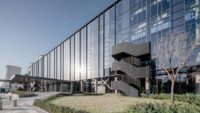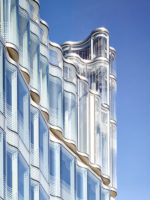It is awards season, the time of year for top lists, best-ofs, and nominations for prizes not yet won. The American Institute of Architects announced its own version of the Oscars, and we want to offer a shout-out to Thom Mayne, the 2013 AIA Gold Medalist, and to Tod Williams Billie Tsien Architects, for winning the 2013 AIA Architecture Firm Award. These designers have produced exemplary work that we've been proud to publish in the pages of this magazine for many years.
In fact, as you've already noticed, we're featuring in this issue the latest project from Mayne's firm, Morphosis: the Perot Museum of Nature and Science in Dallas. Mayne once told me that he suffered from anxiety dreams about figures of authority–clearly the nightmare of a California rebel designer, whose innovative and aggressive aesthetic only gradually won the hearts of major patrons. The General Services Administration and other key government and institutional clients caught up with his edgy ideas–and maybe Mayne has mellowed a bit, too. The architect of such iconic civic buildings as the Caltrans District 7 Headquarters in Los Angeles (RECORD, January 2005) and the San Francisco Federal Building (RECORD, August 2007), he found himself revising his initial sprawling, angular design for the Perot Museum into a cube, in response to the client's wishes for stackable, more conventional galleries. Still, the building is full of elements that are, blessedly, way out there, including an angled glass box that carries an escalator, and an exterior wrapped in tissue-like shirred concrete–think Issey Miyake on speed.
The building is the firm's first museum, and we're showing it alongside two other new American museums designed by Mayne's fellow Pritzker laureates Zaha Hadid and Herzog & de Meuron. Given the architects' outsize reputations, these projects are surprisingly modest–Hadid's Broad Museum in Michigan in scale, and Herzog & de Meuron's Parrish Art Museum on Long Island in scope (after the recession kicked in, the Swiss misters cleverly reworked their original design and slashed the budget by two-thirds). Yet neither project scrimps on material craftsmanship, whether in the knife-edged steel louvers of the Broad or the beautifully scarred concrete of the Parrish's exterior walls.
But it is Williams and Tsien who are particularly revered for raising material craftsmanship to a high art in their work. The small 27-person office has completed a number of projects in the last year or so–most notably the Barnes Foundation in Philadelphia. In our special issue “Building for Social Change” (RECORD, March 2012), we published their Center for the Advancement of Public Action, in Vermont. We're also big fans of their new Logan Center for the Arts, at the University of Chicago, and the Asia Society, in Hong Kong. The husband-and-wife team is known not for a signature style but for an architecture of deeply embedded values: Their work expresses the beauty of making, with a strong sense of purpose and place.
This month, too, in our annual feature “Schools of the 21st Century,” we look at the work of designers committed to rethinking the environments in which children learn best: flexible interior spaces that are filled with daylight. Sadly, in the wake of the tragic shooting at Sandy Hook Elementary School in Connecticut, we also are thinking more about security, but in ways that don't compromise an open learning experience.
Designing great schools is just one way architects honor the profession. As we enter 2013, we at RECORD will continue to search for projects that are innovative and compelling–and that contribute significantly to the public realm and to improving human welfare all over the world.
In their first monograph, Work/Life (2000), Williams and Tsien wrote, “We see architecture as an act of profound optimism.” We could not say it better ourselves.





Post a comment to this article
Report Abusive Comment